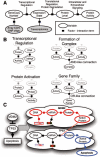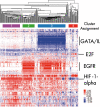Inference of patient-specific pathway activities from multi-dimensional cancer genomics data using PARADIGM
- PMID: 20529912
- PMCID: PMC2881367
- DOI: 10.1093/bioinformatics/btq182
Inference of patient-specific pathway activities from multi-dimensional cancer genomics data using PARADIGM
Abstract
Motivation: High-throughput data is providing a comprehensive view of the molecular changes in cancer tissues. New technologies allow for the simultaneous genome-wide assay of the state of genome copy number variation, gene expression, DNA methylation and epigenetics of tumor samples and cancer cell lines. Analyses of current data sets find that genetic alterations between patients can differ but often involve common pathways. It is therefore critical to identify relevant pathways involved in cancer progression and detect how they are altered in different patients.
Results: We present a novel method for inferring patient-specific genetic activities incorporating curated pathway interactions among genes. A gene is modeled by a factor graph as a set of interconnected variables encoding the expression and known activity of a gene and its products, allowing the incorporation of many types of omic data as evidence. The method predicts the degree to which a pathway's activities (e.g. internal gene states, interactions or high-level 'outputs') are altered in the patient using probabilistic inference. Compared with a competing pathway activity inference approach called SPIA, our method identifies altered activities in cancer-related pathways with fewer false-positives in both a glioblastoma multiform (GBM) and a breast cancer dataset. PARADIGM identified consistent pathway-level activities for subsets of the GBM patients that are overlooked when genes are considered in isolation. Further, grouping GBM patients based on their significant pathway perturbations divides them into clinically-relevant subgroups having significantly different survival outcomes. These findings suggest that therapeutics might be chosen that target genes at critical points in the commonly perturbed pathway(s) of a group of patients.
Availability: Source code available at http://sbenz.github.com/Paradigm,.
Supplementary information: Supplementary data are available at Bioinformatics online.
Figures









Similar articles
-
DINGO: differential network analysis in genomics.Bioinformatics. 2015 Nov 1;31(21):3413-20. doi: 10.1093/bioinformatics/btv406. Epub 2015 Jul 6. Bioinformatics. 2015. PMID: 26148744 Free PMC article.
-
NOJAH: NOt Just Another Heatmap for genome-wide cluster analysis.PLoS One. 2019 Mar 28;14(3):e0204542. doi: 10.1371/journal.pone.0204542. eCollection 2019. PLoS One. 2019. PMID: 30921318 Free PMC article.
-
Cancer driver gene discovery through an integrative genomics approach in a non-parametric Bayesian framework.Bioinformatics. 2017 Feb 15;33(4):483-490. doi: 10.1093/bioinformatics/btw662. Bioinformatics. 2017. PMID: 27797769 Free PMC article.
-
Next generation sequencing technologies in cancer diagnostics and therapeutics: A mini review.Cell Mol Biol (Noisy-le-grand). 2015 Oct 30;61(5):91-102. Cell Mol Biol (Noisy-le-grand). 2015. PMID: 26522064 Review.
-
Cancer Genomics.Arch Med Res. 2022 Dec;53(8):723-731. doi: 10.1016/j.arcmed.2022.11.011. Epub 2022 Nov 29. Arch Med Res. 2022. PMID: 36460546 Review.
Cited by
-
The limitations of simple gene set enrichment analysis assuming gene independence.Stat Methods Med Res. 2016 Feb;25(1):472-87. doi: 10.1177/0962280212460441. Epub 2012 Oct 14. Stat Methods Med Res. 2016. PMID: 23070592 Free PMC article.
-
Pathway-based personalized analysis of cancer.Proc Natl Acad Sci U S A. 2013 Apr 16;110(16):6388-93. doi: 10.1073/pnas.1219651110. Epub 2013 Apr 1. Proc Natl Acad Sci U S A. 2013. PMID: 23547110 Free PMC article.
-
Cancer genome sequencing: understanding malignancy as a disease of the genome, its conformation, and its evolution.Cancer Lett. 2013 Nov 1;340(2):152-60. doi: 10.1016/j.canlet.2012.10.018. Epub 2012 Oct 27. Cancer Lett. 2013. PMID: 23111104 Free PMC article. Review.
-
Efficient representations of tumor diversity with paired DNA-RNA aberrations.PLoS Comput Biol. 2021 Jun 11;17(6):e1008944. doi: 10.1371/journal.pcbi.1008944. eCollection 2021 Jun. PLoS Comput Biol. 2021. PMID: 34115745 Free PMC article.
-
Unraveling tumor microenvironment heterogeneity in malignant pleural mesothelioma identifies biologically distinct immune subtypes enabling prognosis determination.Front Oncol. 2022 Sep 27;12:995651. doi: 10.3389/fonc.2022.995651. eCollection 2022. Front Oncol. 2022. PMID: 36237331 Free PMC article.
References
-
- Alizadeh AA, et al. Distinct types of diffuse large B-cell lymphoma identified by gene expression profiling. Nature. 2000;403:503–511. - PubMed
-
- Allison DB, et al. Microarray data analysis: from disarray to consolidation and consensus. Nat. Rev. Genet. 2006;7:55–65. - PubMed
-
- Beer MA, Tavazoie S. Predicting gene expression from sequence. Cell. 2004;117:185–198. - PubMed
-
- BioPAX working group. BioPAX–biological pathways exchange language. Documentation. 2004
Publication types
MeSH terms
Grants and funding
LinkOut - more resources
Full Text Sources
Other Literature Sources

